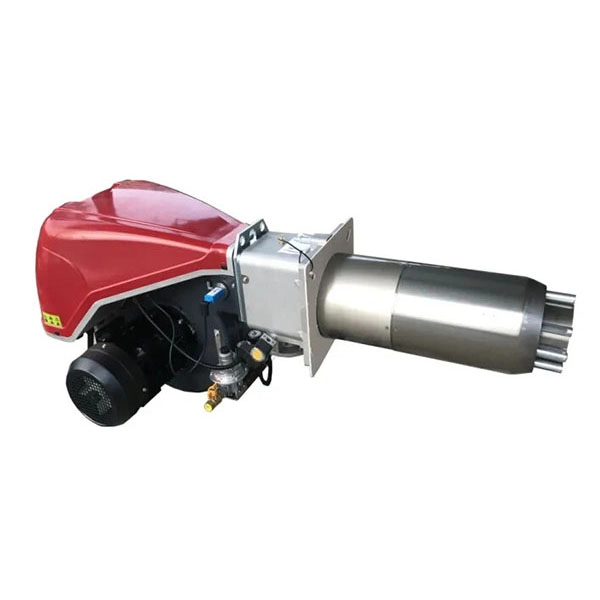
A low nitrogen oil burner is a type of industrial burner designed to reduce the emission of nitrogen oxides (NOx) during the combustion of fuel oil. NOx emissions are a major air pollutant and contribute to acid rain, smog, and respiratory problems.
A low nitrogen oil burner, also known as a low-NOx oil burner, is a type of combustion system designed to significantly reduce the emission of nitrogen oxides (NOx ) during the burning of fuel. This is crucial for industrial applications, such as boilers, furnaces, and power plants, as NOx are a major air pollutant that contribute to the formation of smog, acid rain, and other environmental and health issues.
NOx refers to a group of highly reactive gases that contain nitrogen and oxygen, such as nitric oxide (NO) and nitrogen dioxide (NO2). In combustion processes, NOx is primarily formed in two ways:
Thermal NOx: Formed at high temperatures when atmospheric nitrogen (N2) and oxygen (O2) disassociate and recombine. This is the dominant mechanism in many combustion systems.
Fuel NOx: Formed from the oxidation of nitrogen compounds present in the fuel itself. Fuel oil can contain varying amounts of nitrogen.
Environmental Regulations: Strict environmental regulations worldwide mandate the reduction of NOx emissions from industrial sources.
Air Quality: NOx contributes to the formation of ground-level ozone (smog) and particulate matter, both of which have adverse effects on human health and ecosystems.
Acid Rain: NOx reacts with other atmospheric compounds to form nitric acid, a major component of acid rain.
Low NOx oil burners employ various strategies to minimize NOx formation. These strategies generally focus on:
Lowering Peak Flame Temperatures: Since thermal NOx formation is highly temperature-dependent, reducing the maximum temperature in the flame zone is crucial.
Reducing Oxygen Availability in the Hottest Zones: Limiting the amount of oxygen available where temperatures are highest can inhibit NOx formation.
Optimizing Fuel/Air Mixing: Controlled mixing can prevent localized hot spots and excessive oxygen concentrations.
Here are some common technologies used:
Flue Gas Recirculation (FGR):
Concept: A portion of the cooled flue gas (exhaust gas) is drawn from the stack and mixed with the combustion air entering the burner.
Mechanism: Flue gas is mostly inert (N2, CO2, H2O) and has a high heat capacity. When introduced into the flame, it acts as a diluent, absorbing heat and lowering the peak flame temperature. This directly reduces thermal NOx.
Effectiveness: FGR is a very effective and widely used method for NOx reduction.
Staged Combustion (Air Staging and Fuel Staging):
Concept: Instead of mixing all the fuel and air at once, combustion is divided into multiple stages.
Air Staging: Initial combustion occurs with a fuel-rich mixture (less air than needed for complete combustion). This creates a reducing atmosphere, inhibiting NOx formation. Secondary air is then introduced downstream to complete combustion.
Fuel Staging: Fuel is injected in stages. For example, some fuel is injected into a primary zone, and then additional fuel is introduced into a secondary zone.
Mechanism: By creating fuel-rich or fuel-lean zones, staged combustion avoids the ideal conditions (high temperature, high oxygen) for NOx formation.
Internal Flue Gas Recirculation (IFGR):
Concept: Similar to FGR, but the recirculation of flue gas happens internally within the burner design, often using aerodynamic forces.
Mechanism: Specialized burner designs create pressure differentials that draw hot combustion products back into the primary flame zone, achieving a similar temperature-lowering effect as external FGR without the need for external ducting.
Lean Premixed Combustion:
Concept: Fuel and air are thoroughly mixed before entering the combustion zone, creating a lean (excess air) mixture.
Mechanism: The lean mixture leads to lower flame temperatures and a more uniform temperature profile, reducing hot spots and thermal NOx. This is more common in gaseous fuels but can be adapted for oil.
Water/Steam Injection:
Concept: Water or steam is injected directly into the flame.
Mechanism: The water or steam absorbs heat as it vaporizes and heats up, thus lowering the flame temperature and reducing thermal NOx. This can be effective but also reduces efficiency slightly and requires a water treatment system.
Low Swirl Burners:
Concept: These burners operate with less intense swirling of the combustion air compared to traditional high-swirl burners.
Mechanism: Reduced swirl can lead to a longer, more diffuse flame, which can have lower peak temperatures and more gradual mixing, thus reducing NOx.
A typical low NOx oil burner will include:
Oil Atomizer: Sprays fuel oil into fine droplets to facilitate efficient combustion.
Air Register/Damper: Controls the flow of combustion air.
Ignition System: Sparks or pilot flame for initiating combustion.
Flame Scanner: Monitors the presence and quality of the flame for safety.
Combustion Fan: Provides the necessary air for combustion.
Control System: Manages fuel and air flow, FGR rates (if applicable), and monitors operating parameters to maintain optimal low NOx performance and efficiency.
Take every customer request seriously.

Shuxin
Electromechanical
+86 15516359168
shuxin@sxburner.com
Room 504, Building 11, Wuzhou International Industrial Expo City, Old National Highway 310, Xigong District, Luoyang City, Henan Province
+86 15516359168
shuxin@sxburner.com
Room 504, Building 11, Wuzhou International Industrial Expo City, Old National Highway 310, Xigong District, Luoyang City, Henan Province